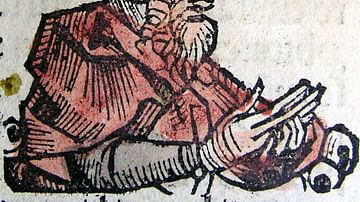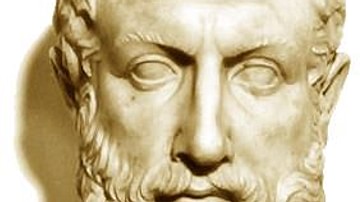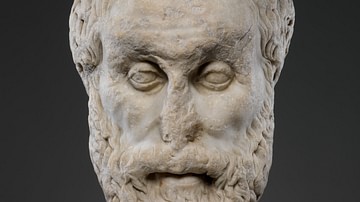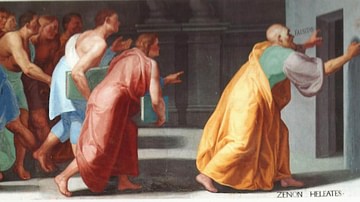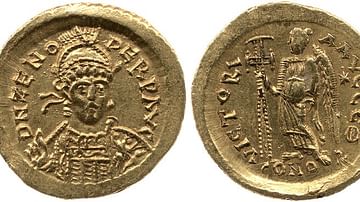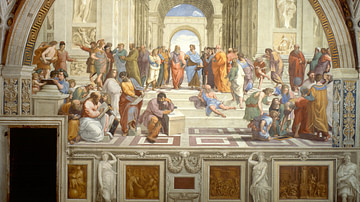
Zeno of Elea (l. c.465 BCE) was a Greek philosopher of the Eleatic School and a student of the elder philosopher Parmenides (l.c. 485 BCE) whose work influenced the philosophy of Socrates (l. c. 470/469-399 BCE). Zeno and Parmenides are both defined by modern-day scholarship as Pre-Socratic philosophers in that their work pre-dates Socrates.
The conclusions drawn by the Pre-Socratic philosophers and Socrates would later be developed by Socrates' students, most famously by Plato (l. 428/427-348/347 BCE) who would then influence his student Aristotle (l. 384-322 BCE) and Zeno’s particular contribution to this was the establishment of dialectic, a method of philosophical inquiry and argument best known from Plato’s dialogues. The works of Plato and Aristotle would later form the basis of Western philosophy and influence the development of the philosophical underpinnings of the three great monotheistic religions of Judaism, Christianity, and Islam.
Little is known of Zeno's life outside of his association with the Eleatic School founded by Parmenides. Parmenides argued against the validity of the senses and the supposed truth they reveal about the world. As with all of the extant writings of the Pre-Socratic philosophers, Parmenides' work seeks to establish the underlying form of being - the First Cause - that essential 'stuff' from which all of life and the sensible world comes.
Parmenides claimed that the previous definitions for this 'stuff' were wrong in that they posited individual elements like water (according to Thales of Miletus, l. c. 585 BCE) or Air (according to Anaximenes, l. c. 546 BCE) when, actually, neither of these could be the First Cause because they were a part of observable, experiential, reality. The First Cause had to be the underlying form behind reality, Parmenides said, and he claimed that this underlying form was actually reality itself (which he called Being) and all of reality and observable existence was One. His claims were clarified by Melissus of Samos (l.c. 5th century BCE) who is often referenced as the "third Eleatic" after Parmenides and Zeno for his developments of the Monist vision of existence.
Parmenides' Monism
Parmenides is known as the founder of the Monist School which held that reality was uniform, whole, unbroken, and unbreakable and that change was therefore illusory. What one perceives as change in life, including time and motion, is only an alteration in appearance, not in essence. If one were to travel from Athens to Eleusis, for example, one would understand the different streets, buildings, and people one encountered in Eleusis as meaning that this city was different from Athens and that one had changed one's location. In reality, Parmenides said, Athens and Eleusis both share in the uniformity of reality and are, in essence, the same exact place; it is only sense perception which leads one to wrongly conclude that the two are different.
Parmenides would argue that if a person were to place a board and a hammer and a nail on a table, sense perception would indicate three separate objects on that table. To Parmenides, this conclusion would be wrong, however, as the board, hammer, and nail are all composed of the same basic material and participate in the unity of existence and so, in spite of what one might conclude through the senses, the three objects are really one. As Parmenides had many critics who claimed that it was obvious a board, hammer, and nail were different and that Athens and Eleusis were as well, Zeno wrote 40 famous philosophical paradoxes (known as his Arguments on Motion) that sought to prove the truth of his master's claim logically.
Zeno's Paradoxes
Of the 40 paradoxes Zeno is credited with writing, less than ten exist today, preserved in Aristotle’s Physics. It is unknown what topics the others addressed but those that have survived focus on the impossibility of motion. Zeno needed to prove that motion was an illusion because motion = change (one moves from one place to another in a period of time) and, if Being is One and indivisible, change cannot be a part of it.
Arguing against motion, acceptance of sense perception, and the plurality suggested by the senses, he wrote the Paradoxes of Motion as a method of proof to demonstrate that, logically, change and motion cannot exist. His philosophical argument is presented through the paradoxes known as The Race Course, The Achilles, The Arrow, and The Stadium, all making the same basic point. Zeno's paradoxes have fascinated mathematicians and logicians for hundreds of years and have yet to be satisfactorily solved.
The paradox of The Race Course shows how motion is a lie of the senses and cannot logically exist by showing how one can never actually reach any given destination. This paradox claims that, if a runner is to sprint 100 meters, she must first travel half that distance. In order to travel half that distance, she must first travel half that distance and, to do that, she must first travel half that distance. By this progression, Zeno showed that, no matter how small a distance was left, it was still impossible, logically, for the runner to ever meet her goal. No matter how far or near, there would always be a distance which separated the runner from the goal because of the infinite divisibility of the halfway mark. Since motion is impossible, Zeno claims to prove, change is impossible and all of perceived reality must be One, unchanging, uncreated, and eternal. Arguments against this, he would say, stem from illusion created by sense perception.
The Achilles presents the same argument but uses two figures, a fast runner (a powerful man such as Achilles), pursuing a slow runner who has a significant head start. Zeno argues that the slow runner will never be overtaken by the fast runner because, at any given time, the fast runner must first reach the point where the slow runner began to run and must then reach the halfway point between that spot and where the slow runner is up ahead and since, as with The Race Course, there are multiple halfway points, the fast runner cannot catch the slow one and so motion, and change, are illusory. An able athlete, Zeno contends, could not even catch up to the slowest runner because that runner would always be ahead.
In The Arrow, Zeno again argues against the possibility of motion by first establishing that any material object, by its nature, occupies space. When an arrow is fired from a bow it appears to move through space but, because it is a material object, it must occupy the space it is in and, moment-by-moment, it is motionless in that space. The arrow may appear to move through the air but, logically, is not actually moving at all. His paradox of The Stadium presents the same argument as the others but uses multiple people moving in different directions in a stadium’s field to make the point.
Parmenides’ claim and Zeno’s paradoxes sounded absurd to an ancient audience (as they well might to a modern one) but their claim was that all things must come from something – nothing comes from nothing – but Being does not suggest a point of origin. Being has always existed and has always existed as a single essence. People perceive different entities, objects, and animals as Many but these Many are One in essence. Appearances might change – it may seem an arrow is flying from one point to another – but these appearances cannot, in any way, affect the essence of unchangeable reality.
Plato's Criticism
Among those who were critical of the paradoxes was Plato. Plato's philosophy was significantly influenced by Parmenides in the development of his Theory of Forms, a higher realm of Truth of which the observable world was only a reflection. Like Parmenides' unchanging essence, Plato's Forms were perfect, eternal, and informed the world of the senses which was largely illusory. At the same time, however, Plato criticized Zeno's paradoxes as establishing confusing paradigms and missing the fundamental truth of Oneness.
In his dialogue of the Parmenides, Plato sets down the fundamental criticism of the claims of Parmenides and Zeno when he has Socrates say:
If a person could prove the absolute like to become unlike, or the absolute unlike to become like, that, in my opinion, would indeed be a wonder; but there is nothing extraordinary, Zeno, in showing that the things which only partake of likeness and unlikeness experience both. Nor, again, if a person were to show that all is one by partaking of one, and at the same time many by partaking of many, would that be very astonishing. But if he were to show me that the absolute one was many, or the absolute many one, I should be truly amazed. And so of all the rest: I should be surprised to hear that the natures or ideas themselves had these opposite qualities; but not if a person wanted to prove of me that I was many and also one. When he wanted to show that I was many he would say that I have a right and a left side, and a front and a back, and an upper and a lower half, for I cannot deny that I partake of multitude; when, on the other hand, he wants to prove that I am one, he will say, that we who are here assembled are seven, and that I am one and partake of the one. In both instances he proves his case.
So again, if a person shows that such things as wood, stones, and the like, being many are also one, we admit that he shows the coexistence the one and many, but he does not show that the many are one or the one many; he is uttering not a paradox but a truism. If however, as I just now suggested, someone were to abstract simple notions of like, unlike, one, many, rest, motion, and similar ideas, and then to show that these admit of admixture and separation in themselves, I should be very much astonished. This part of the argument appears to be treated by you, Zeno, in a very spirited manner; but, as I was saying, I should be far more amazed if anyone found in the ideas themselves which are apprehended by reason, the same puzzle and entanglement which you have shown to exist in visible objects. (127E)
In this passage, Socrates is asking how the `many' can be `one' in the physical, not just the abstract, world. The board, hammer, and nail placed on the table are, clearly, three objects which do not partake in the properties of each other. The board is made of wood, the hammer of wood and metal, the nail of metal alone. These objects cannot possibly be categorized as `one' but must, of necessity, be considered `many'. Since, according to Socrates' argument here, Zeno never moves beyond observable phenomena to make his point, the truth of the uniformity of reality remains unproven.
Zeno's Response
Zeno countered this argument by showing that the `many' have to be `one' because, for plurality to exist, logic could not. Since logical sequence and understanding does exist, there can be no plurality. Professor J. M. Robinson comments on this:
As we can see from the first hypothesis of the first argument of Zeno's treatise, the thesis that things are a many give rise to consequences that are inconsistent even with one another; for if things are a many they must be `both like and unlike' and this is impossible not because it violates sense perception (which is, after all, fallible), but because it violates the law of contradiction, which lies at the basis of all thought. (128)
One cannot, then, claim that the board, hammer, and nail are `many' in that the three objects partake of the same basic substance of the One. A person may look at the three objects and claim there are `many' objects on the table but that would only be an expression of trust in sense perception, not a valid apprehension of the truth. Further, the claim that there is a “many” which constitutes reality, instead of a One, makes logic impossible because one would then be dealing with the many realities of each individual person but, because logical discourse and philosophical argument is possible, there must be some common ground shared by all; this common ground is Being.
Conclusion
Zeno maintained that trust in the senses leads to contradictory conclusions, in that something which exists and 'is' cannot not exist and not be, and yet one's senses tell one that everything is always changing from what it 'is' to something it 'is not'. Sense perception supports the claim of the Pre-Socratic philosopher Heraclitus (l. c. 500 BCE) - with whom both Parmenides and Zeno disagreed - that "Life is Flux" and everything is in constant motion and transformation. To Heraclitus, the First Cause was fire - a transformative element - and this reflected the actual nature of life which was, in fact, constant change itself.
To Zeno, this was a faulty conclusion based upon unreliable sense perception. That which is cannot not be because it would then contain within itself the contradiction of having the qualities of `being' and `not being' and, as this defies logic, it cannot be held as true. In this, both Parmenides and Zeno were at complete odds with the philosophy of Heraclitus but, at the same time, seemed to share his belief that the majority of human beings could not, or would not, seek to understand the truth behind the apparent reality which the senses provide. Although all three philosophers argued against acceptance of sense perception as truth, they acknowledged that people in general are more comfortable with calling their perceptions and opinions “truth” than questioning them.
That concession to each other would be as far as they would go, however, in that the philosophical vision of Heraclitus was completely opposed to the Monist view. Parmenides' Monism and Zeno's paradoxes could admit no truth of plurality and remain cohesive. In their view, they did not have to because one could admit to the appearance of change without acknowledging any kind of change in the essence of fundamental reality.
